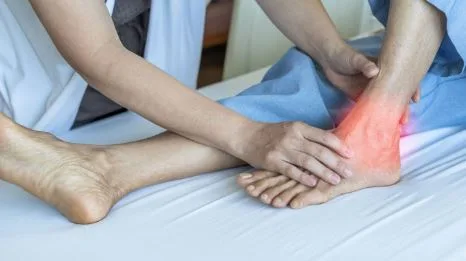Can You Wear Regular Footwear When Recovering from Tendonitis?
Tendonitis can sneak up on anyone, whether you’re an athlete, a weekend warrior, or someone who just spends a lot of time on their feet. The pain and stiffness often start off mild, then gradually interfere with your everyday movement. One of the most common questions people ask during recovery is whether they can continue wearing their usual shoes. It’s tempting to stick with the sneakers or boots you’ve already broken in, but your footwear could either help or slow down healing.
While it’s possible to wear regular shoes depending on the severity of your condition, choosing the right support matters. That’s where recovery footwear comes in. Designed to reduce strain on the inflamed tendon, these shoes can offer more targeted support than many off-the-shelf styles.
Why Footwear Matters During Recovery
The type of shoes you wear directly impacts how your tendons respond to pressure, motion, and load. Tendonitis is often caused by overuse, improper alignment, or repetitive stress. Without proper support underfoot, you’re more likely to keep aggravating the same tissues that need rest.
When you walk, tendons like the Achilles or those around the ankle, arch, or even the knee are constantly working to stabilize you. Regular footwear might not offer enough arch support or heel cushioning, which can force these tendons to work harder. That’s especially true if your shoes are worn out, too tight, or lack shock absorption.
Signs Your Regular Shoes Aren’t Cutting It
If your current footwear is making recovery worse, your body will probably let you know. Look for these warning signs:
- Increased pain after walking or standing
- A burning or stabbing sensation in the tendon area
- Uneven shoe wear (outer edges are flattened or caved in)
- Lack of arch support when you press into the insole
It’s not just about comfort. Long-term use of unsupportive shoes can delay healing and possibly cause compensatory injuries in your knees, hips, or back.
What to Look For in a Supportive Shoe
If you’re not ready to jump into specialty orthopedic shoes or custom orthotics, you don’t have to. Many over-the-counter shoes offer good features for tendonitis support. Just make sure to look for:
- Firm heel counters: This helps control foot motion and minimizes strain on tendons.
- Arch support: Especially important if you have flat feet or high arches.
- Shock absorption: Soft midsoles and cushioned heels protect your joints from impact.
- Wide toe box: Avoid cramping your toes, which can change your gait.
- Removable insoles: Useful if you want to insert custom orthotics or gel pads.
It’s a good idea to replace your shoes every 300 to 500 miles of walking or running, depending on the material. If the soles are visibly worn, you’re overdue.
Can You Use Inserts Instead?
Yes, shoe inserts can make a huge difference, especially when paired with comfortable, neutral shoes. Gel heel cups, arch inserts, and full-length orthotics help redistribute pressure and ease strain on inflamed areas. Custom orthotics prescribed by a podiatrist are ideal, but even a high-quality over-the-counter pair can help.
However, inserts won’t fix a poorly made or worn-out shoe. If the structure of the shoe is broken down, no insert is going to provide enough support.
When Regular Footwear Might Be Okay
Not everyone with tendonitis needs to run out and buy new shoes right away. If your condition is mild and your current shoes already have the key features mentioned earlier, you might be fine continuing with them.
For example, well-cushioned athletic shoes that fit properly and have arch support could be sufficient for day-to-day activity. That said, it’s a good idea to rotate between pairs and avoid standing or walking in the same shoes all day.
If you’re dealing with peroneal tendonitis, Achilles tendonitis, or posterior tibial tendonitis, you’ll want to be especially cautious. These tendons are closely involved in foot stability, and they’re more sensitive to the wrong kind of motion or lack of support.
When to Make the Switch
If you’ve been treating your tendonitis for over two weeks and haven’t noticed improvement, it’s probably time to reassess your footwear. You should also consider upgrading if:
- Your pain is worse in the morning
- You notice swelling or visible inflammation
- You’re limping or modifying your gait to avoid pain
- Your shoes tilt when placed on a flat surface
Recovery isn’t just about stretching and rest. Your footwear is part of the treatment plan, and overlooking it can mean the difference between getting better and staying stuck in a pain cycle.
Other Helpful Tips for Recovery
Aside from supportive shoes, there are a few other strategies to help you heal faster:
- Use ice after activity to reduce inflammation.
- Elevate your foot at night if swelling is present.
- Stretch regularly, but gently, to avoid aggravation.
- Avoid high-impact activities like running or jumping.
- Consider physical therapy if pain persists beyond a few weeks.
And don’t forget to ease back into your normal routine. Jumping back into long walks or workouts too quickly can restart the injury process.
The Role of Professional Advice
Sometimes, figuring out the right shoes isn’t something you should do alone. A podiatrist or physical therapist can analyze your gait, foot structure, and daily habits. They might suggest something as simple as a different lacing method or as specific as a prescription orthotic.
According to a study published in the Journal of Foot and Ankle Research, wearing supportive footwear and using custom orthotics significantly improved pain and function for individuals with Achilles tendon disorders over 12 weeks. You can find the study here under their open-access journal database.
Final Thoughts
So, can you wear regular footwear when recovering from tendonitis? Sometimes. But you really need to listen to your body and take a close look at the shoes you’re relying on. Not all regular shoes are created equal, and many people don’t realize how much their footwear contributes to their pain.
If you’re not getting better or feel worse after walking around, upgrading your shoes or adding proper support can make a real difference. You don’t need to go to extremes, just be intentional about what goes on your feet, and your tendons will thank you.






